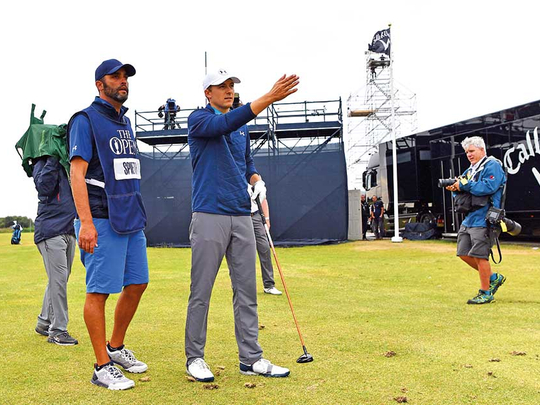
Southport: The history of golfers and caddies — the whole protracted, cherished and tortured lot of it — found one of its apexes Sunday, when a caddie served expertly as both a caddie and a “mental coach,” which is how Jordan Spieth refers to Michael Greller.
As Spieth rode a wacky road to his first British Open and third major title, he cited three crucial junctures at which Greller, the former sixth-grade math teacher from near Seattle, helped him precisely. Two involved words, and one involved yards.
The first came during a front nine during which Spieth, who began with a three-shot lead, blew gaskets all over Royal Birkdale and reminded everyone that, oh yeah, that’s right, he did squander the Masters the last time he led a major. “This was on 7 tee box,” Spieth said. “We walked off 7 tee box, and he made me come back. He said, ‘I’ve got something to say to you. He said, ‘You remember that group you were with?’ “
Greller meant two other Michaels with whom Spieth posted a photo from his recent vacation in Cabo San Lucas: Michael Phelps and Michael Jordan. Continuing, via Spieth: “‘You’re that calibre of an athlete. But I need you to believe that right now because you’re in a great position in this tournament. This is a new tournament. We’re starting over here.’ “
From the restart came five pars wrapped around a bogey from a clunky missed two-footer but then No. 13, where Spieth’s tee shot strayed right and wound up much closer to, say, Liverpool, than intended. Once a bizarre 21-minute delay and a decision about where to hit a drop had settled, the yardage remained unsettled. “I was somewhere around 270 to the front,” Spieth said, “and Michael was like, ‘Buddy, you’re 230 to the front,’ somewhere around there ... And typically I would, if you asked me who has the better yardage, myself or Michael in a lot of situations, when we’re on a crazy angle, I’d pick myself. And on that one he seemed very confident. He was very adamant about what club to hit, and it gave me the confidence to hit it because sometimes when that happens I’ll still go with what I think.”
Spieth wanted a 3-wood and Greller a 3-iron, and the ball the 3-iron struck travelled over the dune and landed safely to the front and right of the green.
“He was right on,” Spieth said.
“It was cool,” Greller said of the fiasco on No. 13, before saying, “Well, it wasn’t cool.” But what was cool, he said, was “we’d been in that situation enough,” so they knew to slow down, and boy, did they slow down.
After the ensuing bogey that led to an astonishing four-hole surge of 5 under par, and in a world in which caddies are closer to equal to their bosses than ever, Greller summoned Spieth again. After the eight-foot bogey putt Spieth would call “massive,” “I was walking off the green,” Spieth said, “and Michael said, ‘Hey,’ and he held me up, and he said, ‘That’s a momentum shift right there.’ And he was dead on. And all I needed to do was believe that. I was starting to feel it, but when he was feeling it and he was saying, ‘That was a momentum shift, even though you lost the hole, you went one down.’”
From there, Spieth rained in monster putts of 48 feet for eagle and 30 for birdie because, Greller said, “He’s got the best instincts in the world at that range.”
Soon, Spieth spoke of the meaning of Greller and his coach, Cameron McCormick, calling McCormick the coach off the course and Greller the coach on the course. “I think this was the best,” Greller said. “He’s hurt a lot since the ‘16 Masters, and I’m sure somewhere in there some doubts crept in, and he just said, ‘You know what? I know how to do this.’”
“I’ll never forget what Michael, how he told me that [at the No. 7 tee box], when he told me that and the significance that it had,” Spieth said. While he credited himself with “some resiliency,” he made a point of saying, “Give a lot of credit to the guy on the bag for that.”
— The Washington Post








